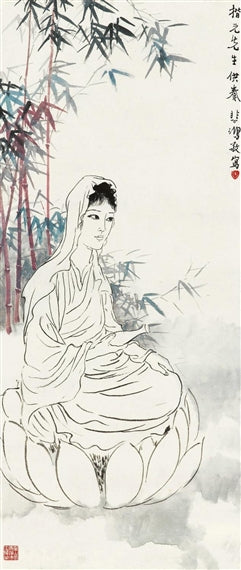Description
In the "Bodhisattva" painting of Xu Beihong, we contemplate a work that emerges from the depths of the author's artistic and spiritual soul. Xu Beihong, known for his ability to merge traditional Chinese techniques with elements of Western art, presents here a manifestation achieved of his mastery and his constant search for cultural and spiritual expression.
When observing the painting, the first thing that attracts attention is the central and unique figure, recognizably a bodhisattva, which stands in the composition. The figure is represented with a dignified serenity and composure, dressed in traditional clothes that flow with an almost ethereal grace. The details in their clothing are thorough, with fine and detailed lines that demonstrate the technical skill of Xu Beihong. This Bodhisattva, who in the Buddhist tradition is a being that has reached lighting but decides to stay in the Samsara to help other beings to reach the same state, is represented with a great nobility and compassion on his face.
The use of color in "Bodhisattva" is delicate and subtle. Xu Beihong uses a limited but effective palette, with soft tones that accentuate the spirituality of the subject and suggest an atmosphere of tranquility and meditation. The dominant colors are white and various gray nuances, with light brown touches in the garments and a background that seems to fade into nothing, creating an almost dream effect. This chromatic choice not only highlights the central figure but also serves to generate a feeling of infinity, suggesting a connection between the Bodhisattva and spiritual infinity.
The artistic composition of the work is simple but powerful. Xu Beihong places the Bodhisattva in the center of the painting, creating an immediate focal point that directs the viewer's gaze towards the sacred figure. The absence of a detailed scenario or other auxiliary elements reinforces the importance of Bodhisattva, raising it almost to a plane of reverence in painting. The economy of elements in the composition shows a clarity of vision that is characteristic of the style of Xu Beihong, who knew how to apply the principle of "less is more" with great effect.
Xu Beihong, born in 1895 and died in 1953, was a pioneer in the modernization of Chinese art. His work was distinguished by the incorporation of techniques and perspectives of the West, which he acquired during his studies in Europe, without giving up the roots of Chinese artistic traditions. In "Bodhisattva", these influences become evident in anatomical precision and the use of negative space, elements that show their ability to integrate and reconcile these two artistic worlds.
The spiritual approach that Xu Beihong adopts in this piece is also remarkable. Through the figure of Bodhisattva, the artist seems to invoke not only the greatness and holiness of the Buddhist subject, but also an invitation to contemplation and introspection. It is an invitation to look beyond the worldly and the earthly and to approach the highest principles of the soul and spirit.
In summary, "Bodhisattva" is a work that encapsulates the artistic ethos of Xu Beihong. Through its balanced composition, its sophisticated use of color and its deep spiritual reference, painting offers us a window to the wealth of the cultural and spiritual tradition that the artist always sought to preserve and renew. It is a work that not only delights the senses, but also enriches the spirit.
KUADROS ©, a famous paint on your wall.
Hand-made oil painting reproductions, with the quality of professional artists and the distinctive seal of KUADROS ©.
Art reproduction service with satisfaction guarantee. If you are not completely satisfied with the replica of your painting, we refund your money 100%.

